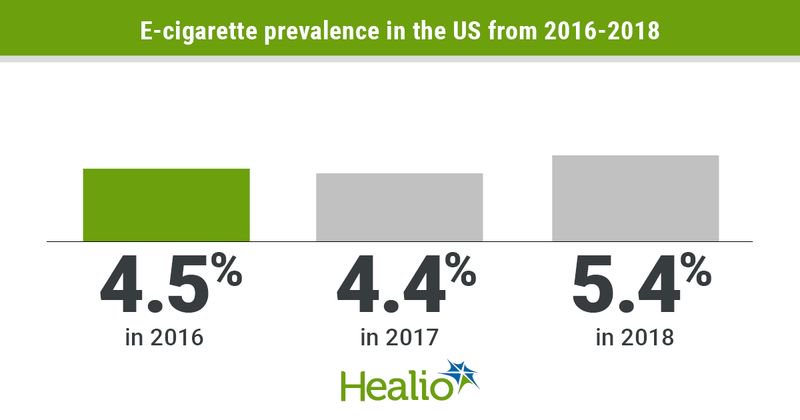E-cigarette use rose in recent years, especially in young adults, students
The prevalence of e-cigarette use increased from 2016 to 2018, with the largest rises in young adults and students, researchers reported in JAMA Internal Medicine.
Researchers analyzed 1,156,411 U.S. participants from the Behavioral Risk Factor Surveillance System 2016-2018 with information on e-cigarette use (never, former or current). Participants self-reported information on demographics, cigarette smoking status, chronic health conditions and health-risk behaviors, such as other tobacco use, heavy alcohol use, marijuana use and binge drinking.

Overall, the prevalence of e-cigarette use was 4.5% (95% CI, 4.4-4.6) in 2016, 4.4% (95% CI, 4.3-4.5) in 2017 and increased to 5.4% (95% CI, 5.2-5.6) in 2018. According to the researchers, this translated to 11.2 million U.S. adults using e-cigarettes in 2016, 11 million in 2017 and 13.7 million in 2018.
The largest increase in prevalence was in those aged 18 to 24 years, from 9.2% in 2016 to 15% in 2018. There was also a marked increase in prevalence among students, from 6.3% in 2016 to 12% in 2018.
Among never smokers, researchers observed a significant increase in e-cigarette use prevalence, from 1.4% in 2016 to 2.3% in 2018. Participants who participated in health-risk behaviors demonstrated higher increases in e-cigarette use prevalence compared with those who did not.
According to researchers, there was a significant shift toward daily use and sole e-cigarette use from 2016 to 2018, especially in young adults and students.
“The significant increase in daily e-cigarette use suggests that more users are becoming dependent on e-cigarettes rather than merely experimenting with them,” Olufunmilayo H. Obisesan, MD, MPH, postdoctoral research fellow at the Johns Hopkins Ciccarone Center for the Prevention of Cardiovascular Disease, and colleagues wrote. “This is concerning among younger adults because early use of e-cigarettes has been associated with subsequent cigarette smoking, as well as drug and alcohol use.”
Trends in U.S. e-cigarette use in all 50 states and three territories were similar, as was a subanalysis of trends in the 33 states with e-cigarette use documentation in 2018.
“Previous studies report a strong association between exposure to e-cigarette marketing and its subsequent use. We speculate that increased e-cigarette advertisement expenditure over the years and increased social media presence correlates with increased e-cigarette use, especially in the youngest age group,” the researchers wrote. “The increase in e-cigarette use among individuals exhibiting other health-risk behaviors, particularly marijuana use, is concerning especially in light of the outbreak of e-cigarette, or vaping, product use-associated lung injuries that has been linked to the vaping of tetrahydrocannabinoids.”
